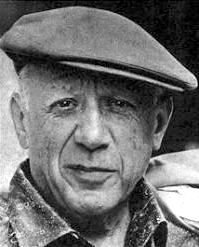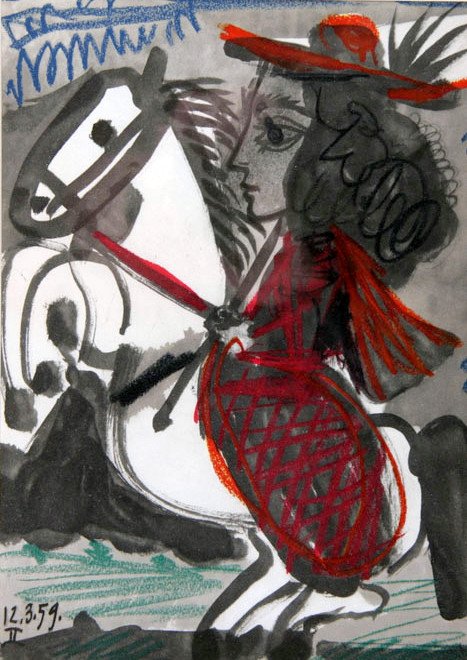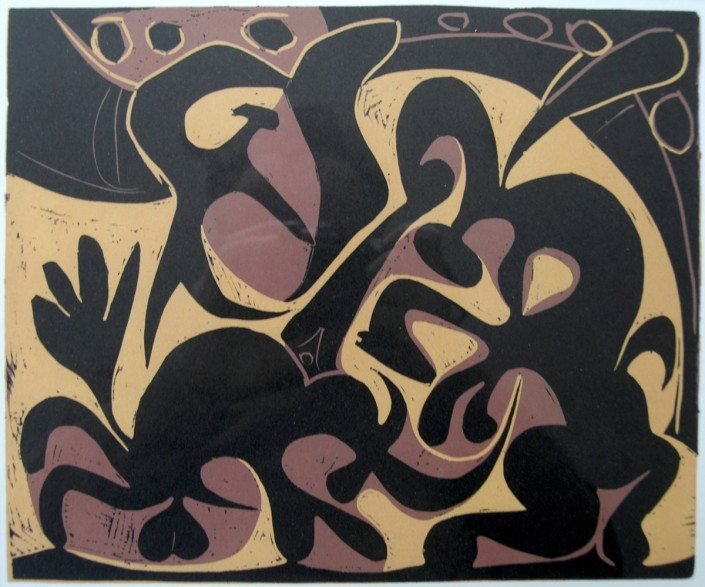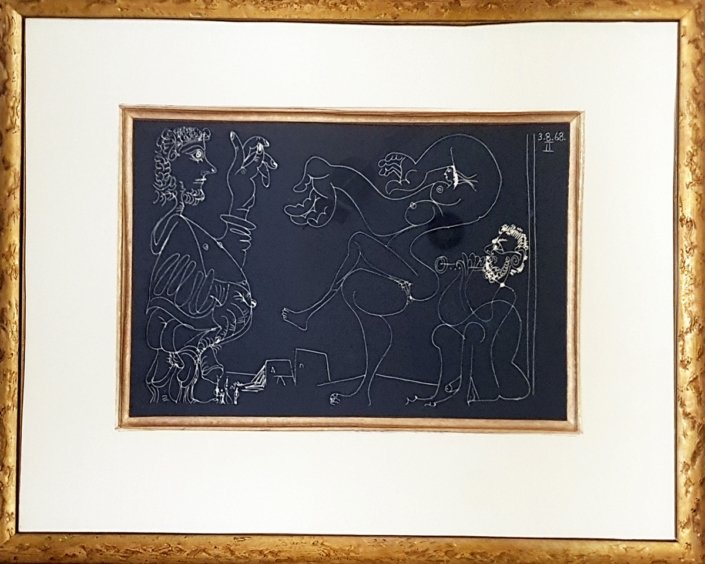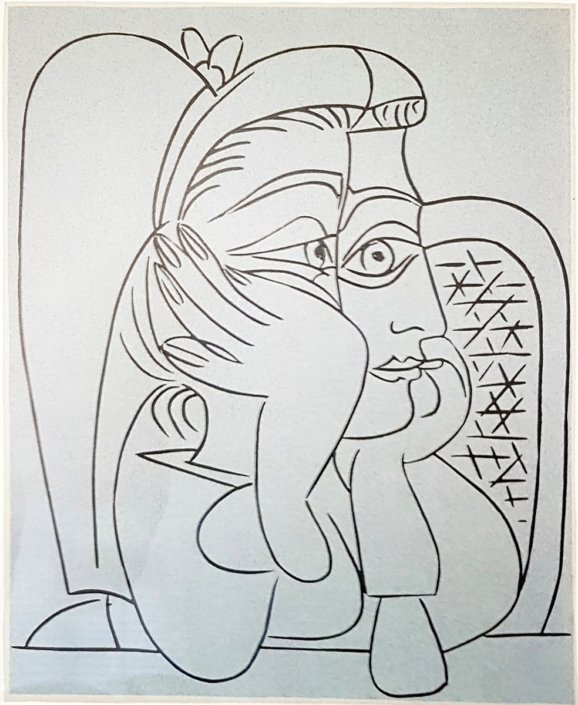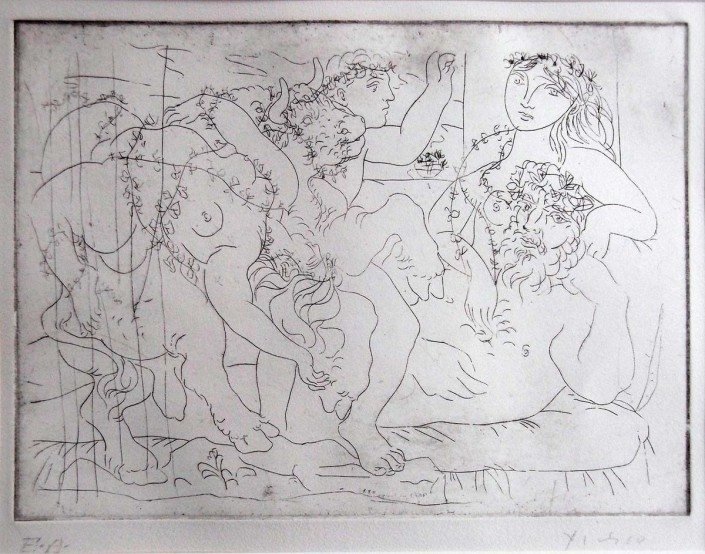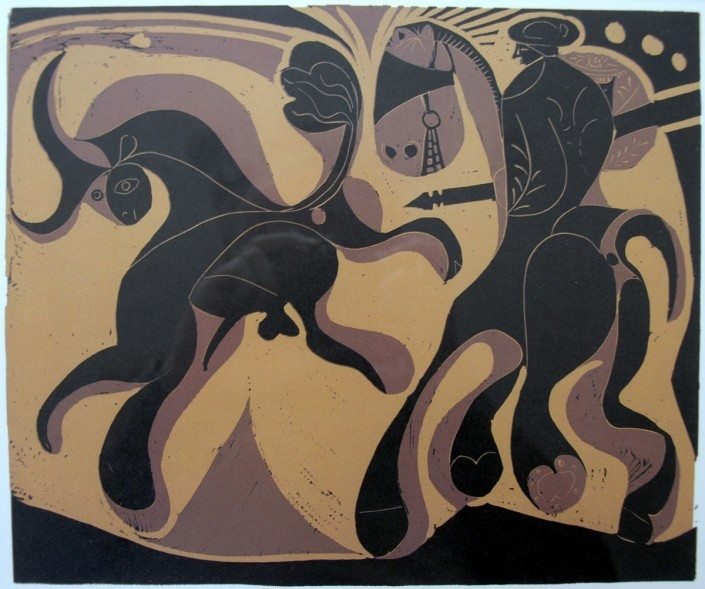Pablo Picasso (Málaga 1881 – Mougins (Frankrijk) 1973)
Pablo Picasso kan zonder overdrijving de meest creatieve en veelzijdige kunstenaar van de 20ste eeuw genoemd worden. Naast zijn talloze schilderijen manifesteerde hij zich ook als graficus, ceramist, tekenaar, decor- en kostuumontwerper en beeldhouwer. Zijn vader was ook kunstenaar en begeleidde hem bij zijn eerste stappen op het gebied van de schilderkunst. Al jong kwam zijn artistieke talent aan het licht, en met 16 jaar werd hij toegelaten tot de academie in Madrid. Voornamelijk verbleef hij echter in Barcelona, waar hij zijn eerste tekeningen, meest portretten, tentoonstelde. In 1900 reisde hij met een vriend naar Parijs en betrok daar een atelier in de Rue Gabrielle, waar hij vermoedelijk zijn eerste in Parijs ontstane schilderij vervaardigde: Moulin de la Galette. Zijn eerste expositie hield hij in 1901 en in die tijd begon zijn beroemde blauwe periode. In 1904 vestigde hij zich definitief in Parijs waar hij in 1907 samen met Georges Braque het kubisme ontwikkelde. Deze nieuwe fase in het scheppend vermogen van Picasso ontstond met zijn baanbrekende werk Les Demoiselles d’Avignon (1906-1907). Zijn stijl bewoog zich echter in verschillende richtingen; een bepaalde stijl werd meestal voor een bepaald onderwerp gebruikt. In kubistische stijl vervaardigde hij een serie stillevens. Tot 1920 komen er steeds minder kubistische werken en tenslotte verdwijnen ze totaal. In 1924 sloot Picasso zich aan bij de surrealisten en exposeerde in 1925 samen met hen in de galerie Pierre. Omstreeks 1931 begon hij zich op het vervaardigen van sculpturen toe te leggen. Zijn eerste grote overzichtstentoonstellingen vonden in 1932 plaats in de Parijse galerie Georges Petit en in het Kunsthaus van Zürich. In 1937 schiep hij het monumentale fresco Guernica als een reactie op de verwoesting van het Baskische stadje door Duitse vliegtuigen tijdens de Spaanse burgeroorlog. Vanaf begin jaren veertig is in zijn werk een zekere consolidatie van stijl waarneembaar.
Hij woont dan in Zuid-Frankrijk en werkt vaak in Antibes in het paleis Grimaldi, dat nog tijdens zijn leven als Musée Picasso werd ingericht. In Vallauris begon hij in 1947 zijn keramische werkzaamheden. In zijn latere scheppingsperiode trok behalve zijn schilderkunst tevens zijn grafische werk grote aandacht. Zijn werk werd onder andere verkocht door Heinz Berggruen (Berlijn 1914), vooraanstaand kunsthandelaar en vriend van Picasso.
Pablo Picasso can be called, without exaggeration, the most creative and versatile artist of the 20th century. In addition to his countless paintings, he also manifested himself as a graphic artist, ceramist, draftsman, set and costume designer and sculptor. His father was also an artist and guided him in his first steps in the field of painting. His artistic talent came to light at a young age, and at the age of 16 he was admitted to the academy in Madrid. However, he mainly stayed in Barcelona, where he exhibited his first drawings, mostly portraits. In 1900 he traveled to Paris with a friend and moved into a studio in the Rue Gabrielle, where he probably made his first painting in Paris: Moulin de la Galette. He held his first exhibition in 1901 and at that time his famous blue period began. In 1904 he settled permanently in Paris where he developed cubism together with Georges Braque in 1907. This new phase in Picasso’s creative potential began with his groundbreaking work Les Demoiselles d’Avignon (1906–1907). However, his style moved in different directions; a particular style was usually used for a particular subject. He produced a series of still lifes in the Cubist style. Until 1920, his Cubist works became fewer and fewer, and eventually disappeared altogether. In 1924, Picasso joined the Surrealists and exhibited with them at the Galerie Pierre in 1925. Around 1931, he began to focus on making sculptures. His first major retrospectives took place in 1932 at the Galerie Georges Petit in Paris and at the Kunsthaus in Zurich. In 1937, he created the monumental fresco Guernica as a response to the destruction of the Basque town by German aircraft during the Spanish Civil War. From the early 1940s onwards, a certain consolidation of style is noticeable in his work. He then lived in the South of France and often worked in Antibes in the Grimaldi Palace, which was converted into the Musée Picasso during his lifetime. In Vallauris, he began his ceramic work in 1947. In his later creative period, his graphic work attracted great attention in addition to his painting. His work was sold by, among others, Heinz Berggruen (Berlin 1914), a prominent art dealer and friend of Picasso.

